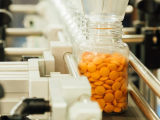In the first 2 years of the COVID-19 pandemic, shortages of 11% of generic active pharmaceutical ingredients (APIs) made by global manufacturers—35% of them from larger facilities in India—were tied to generic-drug unavailability in the United States, according to a research letter posted this week in JAMA.
APIs key to drug quality
Johns Hopkins University researchers analyzed US drug shortage data from the Food and Drug Administration (FDA) from January 2020 to December 2021. The team then matched each shortage to the Clarivate Analytics Cortellis Generics Intelligence (CGI) database, which has information on global generic API manufacturers, and extracted details on all generic APIs bound for the United States.
The information included the number, location, and characteristics of API manufacturing plants; year of the first US abbreviated new drug application; US-licensed generic-drug makers using the API; routes of administration; and therapeutic category.
APIs are key to the quality of prescription drugs, and generic drugs made up about 90% of US prescriptions in 2022, the researchers noted. "In 2014, 9% of drug shortages were attributed to the unavailability of APIs," they wrote. "In addition, APIs could potentially be linked to the 40% of shortages attributed to quality problems and the 30% caused by manufacturing delays and capacity issues."
Shortages lasted 2.3 years on average
The FDA documented 194 drug shortages, which lasted an average of 844.6 days and involved 162 unique generic APIs, of which 91% were also found in the CGI database. The 1,379 US-bound generic APIs in the CGI database were manufactured by 565 firms, with each API made by an average of 3.7 plants.
Relative to APIs not linked to shortages, the 147 shortage-associated APIs (10.7% of 1,379 APIs) were mainly older products (average year of new-drug approval, 1993 vs 2004), linked to more approval holders (average, 7.2 vs 4.1), more likely to be in injectable form or to have multiple routes of administration, and more likely to be neuromuscular or anti-infective.
Identifying API manufacturers linked to shortages could guide FDA inspections and help prioritize approvals of new entrants in vulnerable markets.
The number of manufacturing plants did not differ by shortage association (average, 3.6 vs 3.7). But facilities linked to at least one API in shortage (48.1%) produced more APIs (average, 13.7 vs 4.5), didn't differ by year of last FDA inspection (average, 2017 vs 2018) or receipt of an FDA warning letter (33 vs 35 facilities), and had more non-US inspectors (average, 2.1 vs 1.5) than those making APIs not tied to a shortage.
In total, 35.3% of plants making APIs in shortage were located in India, 12.1% were in Italy, 10.7% were in China, and 9.6% were in the United States.
"Identifying API manufacturers linked to shortages could guide FDA inspections and help prioritize approvals of new entrants in vulnerable markets," the study authors wrote. "Although the pandemic posed additional strain to global supply chains, highlighting the importance of strong generic drug supply chains for national security, drug shortages have continued to increase since then."





















